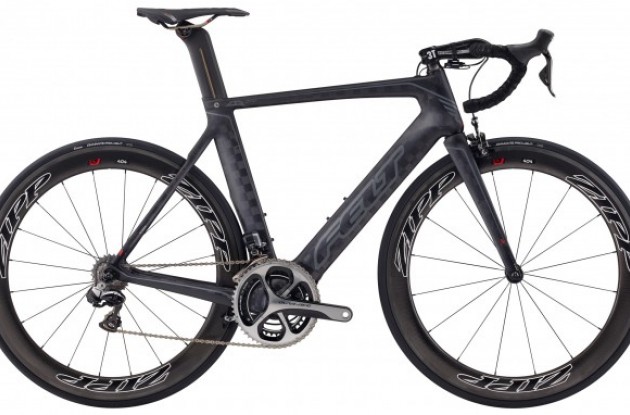Felt AR Road Bike Review
With four stage wins in the 2013 Tour de France, Felt road bikes have had their share of good press. Not willing to rest on these accomplishments, Felt Bicycles went back to the drawing board to improve upon the 2013 models.
At the 2014 Felt product launch Jim Felt, the man who is the driving force behind the company, stood in front of the assembled press and explained how every project starts out with a blank piece of paper. Felt formulates those ideas which are then shaped with multiple visits to the wind tunnel. With the help of a 3-D printer they are able to prototype ideas quickly and test them in the tunnel.
“We have set the bar very high for every company out there,” said Felt. “I’m living my dream.”
Part of that dream is the creation of the 2014 Felt AR road bike line. Felt claims the ’14 AR is 40% stiffer, lighter and more aerodynamic than the AR model of the previous year.
During the creation of the 2014 AR, Felt didn’t want the new model to be dominant in just one frame characteristic at the sacrifice of the other factors. That meant it had to be top of its class in aerodynamics, but in stiffness and weight as well.
“There was a no holds approach to product design,” said Felt’s road brand manager Dave Koesel. “There was no compromise.”
The AR was two years in the works with multiple trips to the wind tunnel for development.
It was in these trips to the tunnel that Felt designers determined that the rounder, “softer” cross sections for the AR frame’s tubes improved aerodynamics in all yaw angles – conditions a rider is more likely to experience in the real world.
In testing Felt said the 2014 AR was one of the fastest bikes across multiple wind angles making it almost 15 percent faster than the 2013 AR model. Tipping the scales at 900 grams the 2014 AR is also lighter than last year’s model by 35 percent.
The AR’s tubes are designed to have the same lift effect as a sail boat. In some wind situations the tubes actually give lift. However, just because the tube shapes are aerodynamic and produce in some situations as little drag as a deep profile wheel, doesn’t mean the AR will propel itself down the road. Once a rider is added to the equation the grams of drag increase. However, in a sprint or long solo effort any type of aerodynamic saving can mean the difference between first and finishing in the middle of the pack.
The new AR might be more aero and lighter, but was that done at the sacrifice of comfort? As mentioned earlier, Felt didn’t want to create a bike that shined in only one performance category. It had to be the best in several.
To improve on the comfort factor Felt redesigned the aero seatpost. As we all know, a seatpost is held in place by the seat binder clamping against it. Due to the shape of aero posts uniform pressure to secure the post is difficult to achieve. However, Felt, in conjunction with Italian parts manufacturer 3T, has created an interesting seatpost for the 2014 AR.
The post is still as aero as a plane’s wing, but what sets it apart from other aero posts is the ability to dampen vibration. Splitting the post on both sides is a grove which allows a degree of dampening. With the post in his hands Koesel was easily able to squeeze it inward showing how it reduces vibration that would normally be transmitted from the frame to the rider. To keep the post from sliding there are two bolts on either side of the post that are positioned in the groove pinching the post on both sides. This clamping system is called Felt’s Internaloc seatpost binder. The pinching uniformly places pressure on the inside as well as the outside of the light-weight post so there’s no fear of slippage.
This seatpost design, according to Felt, takes vibration off of the rider and claims that the damping of the AR falls between the F (their stiffest road race bike model) and the Z Series (endurance model).
Another feature of the post is the 3T created clamp which can be placed in the traditional “laid back” position for the road or if the AR is pressed into a triathlon or time trial, it can be switched to a forward position by simply removing the post and flipping it with the clamp positioned forward. This changes the effective seat tube angle from 72.5 to 78.5 degrees.
The seatpost isn’t the only aerodynamic feature of the AR. The fork crown is formed to meld smoothly into the lower head tube, thereby reducing wind turbulence from the front of the bike. Felt also claims that the larger fork blades not only offer an aerodynamic benefit but also dampen road vibrations.
The back end of the bike are the seat stays, but missing is the rear brake. Instead, the brake is positioned under the bottom bracket. With the rear brake removed from the seat stays weight is further shed by the elimination of the brake bridge. The slim stays are designed to absorb road shock.
The seat tube is also aerodynamically formed so the rear wheel can tuck extremely close to the tube. Felt calls this design the Gap Shield Rear Triangle and improves the flow of air from the frame over the rear wheel. An additional benefit of the foil section of the seat tube is an increase in stiffness to the bottom bracket.
With years spent in the wind tunnel Felt Bicycles has always been considered at the forefront of aerodynamics. The 2014 AR model line shows that this small-sized California bike company is still leading the way.
Learn more about the 2014 Felt AR bike at www.feltbicycles.com.
Prices:
AR FRD (Shimano Di2) $12,499
AR2 (Shimano Ultegra Di2) $6,199
AR3 EPS (Campagnolo Athena EPS) $5,149
AR4 (Shimano Ultegra 11-speed) $3,499
AR5 (Shimano 105 10-speed) $2,499
Frame Kit AR FRD (frame, fork, seat, seatpost) $3,999
Frame Kit AR 1 (frame, fork, seatpost) $2,499








